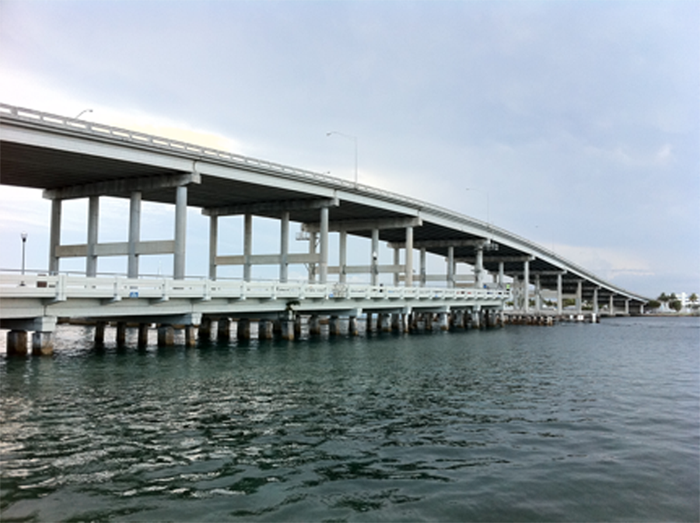Blue Heron Bridge Project Baseline Gulfstream
In an effort to further document the Blue Heron Bridge (BHB) the second phase of the project has commenced. On Sunday July 14th 2013 members of Florida Underwater Explorers (FLUE) Patrick Winkler and Philip Berg in association with Project Baseline Gulfstream focused their attention onto the fishing bridge and rubble pile portion of the BHB dive site.

Blue Heron Bridge Fishing Bridge
Below the surface lies a diverse ecosystem. The main feature is a large rubble pile; remnants of the original BHB overpass. What is unique about this area is the large amount of marine life that inhabits these concrete structures. a non-for-profit initiative encouraging all to participate in the data collection and monitoring of sites. Please reach out to us and contact us to inquire further.
This transect of the rubble pile documenting the diversity of marine life.
However, the marine life is under constant threat from above. The major threat to the site is the loss and entanglement of monofilament line, artificial tackle and other fishing equipment. This rogue fishing equipment poses a threat to all species of marine life.
This area is perhaps the most used portion of the dive site both from above and below. As SCUBA divers we are constrained by certain limits. We have a limited gas supply; we are limited to when we can dive; we have to limit our time underwater because of NDLs and limitations are placed on our mobility. These limits inherently constrain what we can achieve underwater. However, onshore fishing activities are persistent. Fishermen above are only limited by time and their patience. So merely casting a line and having some patience can erase what we achieve underwater.

Entangled Monofilament

Monofilament Debris
This is documentation of the amount of debris that collects underneath the fishing bridge. Despite clean up efforts from divers there is still a large amount of debris buried underneath. Most of the line becomes entangled together and forming large balls of debris. These debris balls then get buried beneath the sand or become lodged in between portions of the structure.
This video documents the removal and disposal of debris below the fishing bridge. As one can see there is monofilament entangled and buried throughout the site. This shows just a small portion of what lies beneath the surface. Further efforts will focus on removal and clean up of this site.
Two days later after a follow up dive was conducted. Again the focus for the dive site over all is to document the water quality. Non-source point pollution is a problem that threatens the BHB. The photos below capture this issue.
Rubble Pile Two Days Before Heavy Rain

Rubble Pile Two Days After Heavy Rains
In the first photo one can see how clear the site can actually be. A secchi disk reading was taken and a reading of 35 feet visibility was recorded. On the follow up dive another secchi disk reading was recorded of 10 feet: a decrease in
visibility of 25 feet. One can clearly see between the two photos how dramatic the decrease in visibility was and the increase of particulate in the water as well as the discoloration.
We encourage you the next time you come out to the BHB bring a collection bag and remove some debris. A small effort by many makes a profound impact.
The Blue Heron Bridge is a monitoring site of Project Baseline Gulfstream. Our goal is to document and report our findings to provide empirical evidence about the overall health and development of this site.
We encourage all divers to share your dive reports, measurements, findings, photos and videos with the community and us. Project Baseline is a non-for-profit initiative encouraging all to participate in the data collection and monitoring of sites. Please reach out to us and contact us to inquire further.

